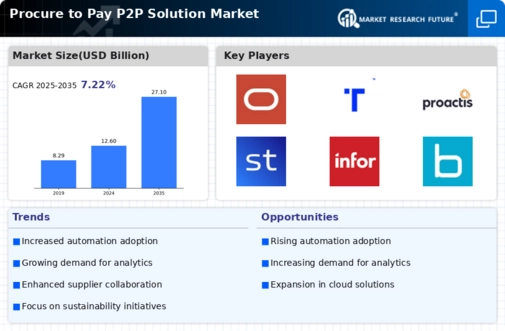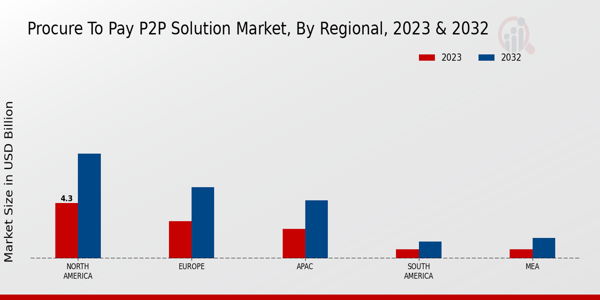Regulatory Compliance
Regulatory compliance is increasingly influencing the Global Procure to Pay P2P Solution Market Industry. As governments worldwide impose stricter regulations on procurement practices, organizations are compelled to adopt P2P solutions that ensure compliance with these standards. This trend is particularly evident in sectors such as healthcare and finance, where adherence to regulations is paramount. Companies utilizing P2P solutions can automate compliance checks and maintain accurate records, thereby mitigating risks associated with non-compliance. Consequently, the demand for P2P solutions is expected to rise as organizations prioritize compliance in their procurement processes.
Market Growth Projections
The Global Procure to Pay P2P Solution Market Industry is projected to experience substantial growth over the coming years. With the market valued at 12.6 USD Billion in 2024, it is anticipated to reach 27.1 USD Billion by 2035. This growth trajectory indicates a compound annual growth rate (CAGR) of 7.22% from 2025 to 2035. Such projections highlight the increasing adoption of P2P solutions across various sectors, driven by factors such as technological advancements, cost efficiency, and the need for regulatory compliance. The market's expansion reflects the growing recognition of the strategic importance of effective procurement processes.
Technological Advancements
The Global Procure to Pay P2P Solution Market Industry is experiencing a surge in technological advancements, particularly in automation and artificial intelligence. These innovations streamline procurement processes, reduce manual errors, and enhance efficiency. For instance, the integration of AI-driven analytics allows organizations to gain insights into spending patterns, thereby optimizing procurement strategies. As businesses increasingly adopt these technologies, the market is projected to grow from 12.6 USD Billion in 2024 to 27.1 USD Billion by 2035, reflecting a robust CAGR of 7.22% from 2025 to 2035. This growth underscores the critical role of technology in transforming procurement operations globally.
Globalization of Supply Chains
The globalization of supply chains is a significant factor driving the Global Procure to Pay P2P Solution Market Industry. As businesses expand their operations internationally, they encounter complex procurement challenges, including managing diverse suppliers and navigating various regulatory environments. P2P solutions facilitate these processes by providing a centralized platform for procurement activities, enabling organizations to manage global suppliers effectively. This trend is likely to contribute to the market's growth, as companies seek to enhance their global procurement capabilities and improve supply chain efficiency.
Increased Focus on Cost Efficiency
Cost efficiency remains a pivotal driver within the Global Procure to Pay P2P Solution Market Industry. Organizations are under constant pressure to reduce operational costs while maintaining quality. By implementing P2P solutions, companies can automate invoice processing and enhance supplier management, leading to significant savings. For example, firms that have adopted these solutions report reductions in procurement costs by up to 30%. This focus on cost efficiency is likely to propel the market forward, as businesses seek to leverage P2P solutions to streamline operations and improve their bottom line.
Growing Demand for Real-Time Data Analytics
The growing demand for real-time data analytics is reshaping the Global Procure to Pay P2P Solution Market Industry. Organizations are increasingly recognizing the value of data-driven decision-making in procurement. P2P solutions equipped with advanced analytics tools enable businesses to monitor spending in real-time, identify trends, and make informed purchasing decisions. This capability not only enhances procurement efficiency but also fosters strategic supplier relationships. As the emphasis on data analytics continues to rise, the market for P2P solutions is poised for substantial growth, driven by organizations' desire to leverage data for competitive advantage.













